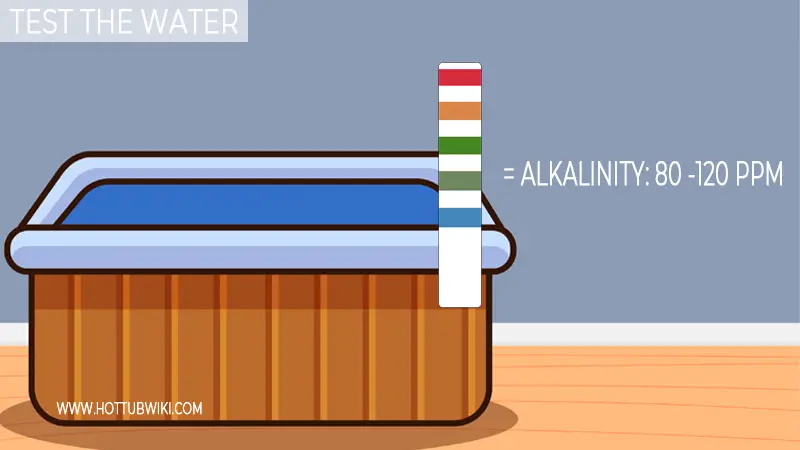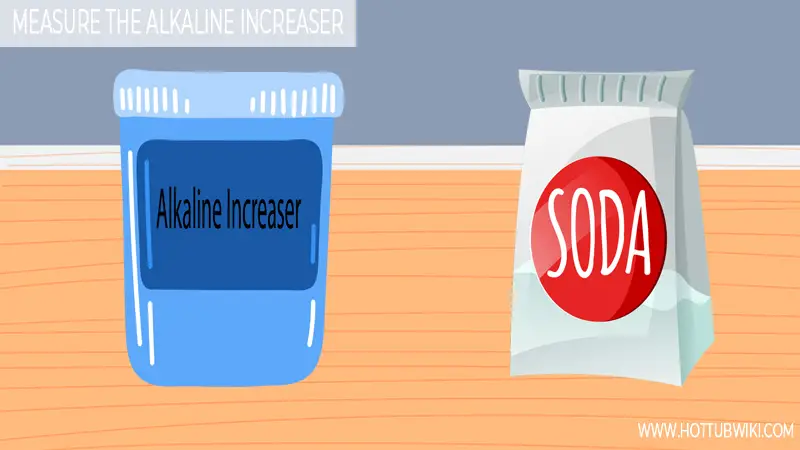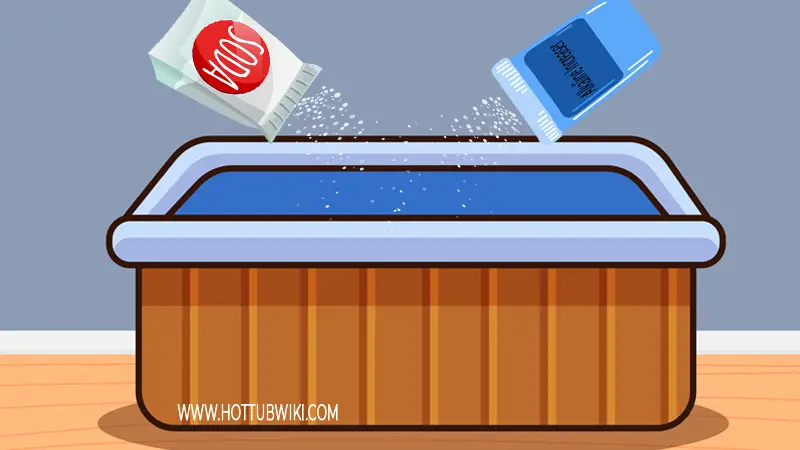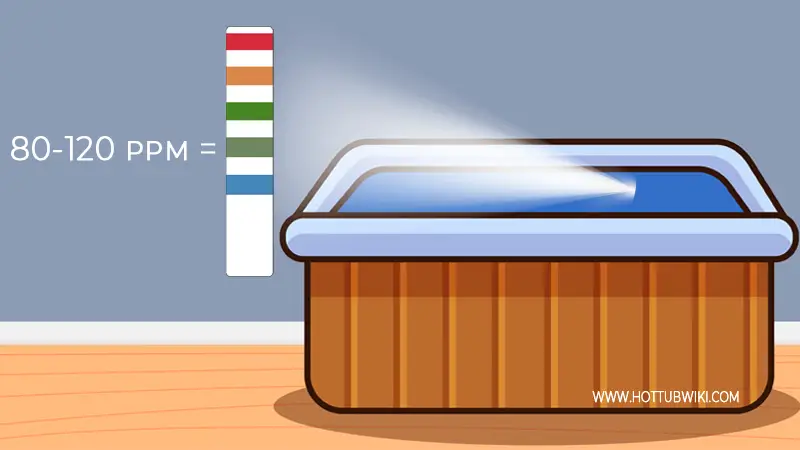Having the right alkalinity level in your hot tub keeps the pH and water chemistry balanced. So how can you raise the alkalinity in a hot tub when it falls? Here is the answer to that.
You can raise the alkalinity of the hot tub by adding an alkalinity increaser to the water. You can also raise the alkalinity by adding a base solution like baking soda to the water.
But there is more to know about raising the alkalinity of your hot tub and this post digs right into the topic.
Let’s dive in.
What Causes Low Alkalinity In A Hot Tub?
The main factor that causes low alkalinity in a hot tub is acidic water. When you add too many chemicals into the water or a high dose of chemicals, the water will become acidic. When this happens, the alkalinity of the water will drop below the recommended range.
Low alkalinity in a hot tub can also be caused by the water source. If you fill your hot tub with rainwater or if a high amount of rainwater is entering the hot tub, then that can lower the alkalinity of the hot tub.
The water in the hot tub is usually over 100 degrees Fahrenheit. Rainwater on the other hand can be as cold as 35 degrees Fahrenheit. When rainwater enters your hot tub, it causes a constant rise and drop in water temperature which will eventually cause low alkalinity.
If you live in areas where acid rain is common, then that can also be the cause of low alkalinity in the hot tub. If the acidic rainwater gets into the hot tub, then it will lower the alkalinity
Low alkalinity in a hot tub can also be caused by contaminants introduced by the bathers. When you soak in the hot tub, the sweat from your body, urine, food residue, and other body care products can also lower alkalinity in a hot tub.
It’s also possible to have low alkalinity in the hot tub if you added too much alkalinity reducer. Products advertised as alkalinity reducers have a high acidic content. If you add too much of such products, then you can have a low level of alkalinity in the hot tub.
Related Read: How To Lower Alkalinity in a Hot Tub?
How To Raise Alkalinity in a Hot Tub?
To raise the alkalinity of your hot tub, you need to add an alkaline increaser or a base solution to the water while the jets are running.
But there are things to do before you can add an alkaline increaser to the water.
1. Test The Water

To increase the alkalinity of your hot tub, you’ll be handling strong chemicals. The alkaline increaser may not be acidic but it will still cause problems if it comes in contact with your skin. So wear long clothing and a pair of gloves.
The next step is to test the water. You need to be sure you have low alkalinity in the hot tub before you add an increaser. You also need to know the level of alkalinity in the hot tub to know how much increaser you need to add to raise it to the recommended range.
Remember you are raising the alkalinity and not the pH. So to test the water, the results of the alkalinity test should be in ppm (parts per million) and not on the pH scale.
The right level of alkalinity to have in your hot tub is between 80 ppm and 120 ppm. Any reading below 80 ppm is too low for your hot tub.
2. Measure The Alkaline Increaser

To increase the alkalinity, you need to add the right amount of alkaline increaser to the water. Check the container of the alkaline increaser. You should see instructions guiding usage on it to know how much you need to add.
Different brands will have will each have their specific amount so ensure to follow the instructions of the alkaline increaser that you are using.
You can also use baking soda if you don’t have access to an alkaline increaser. Baking soda works as well as any alkaline increaser. To use baking soda, measure 1 tablespoon of baking soda per hundred gallons of water. So a 500-gallon hot tub will take 5 tablespoons of baking soda.
3. Turn On The Jets

The next step is to turn on the jets to ensure the water is being circulated before the alkaline increaser is added. If the water isn’t in circulation when you add the alkaline increaser, it would take several hours for the increaser to be fully dispersed in the water.
The jets help the alkaline increaser to mix with the hot tub water quickly and easily. You should turn on the jets on a high setting for maximum efficiency.
4. Add The Alkaline Increaser

After turning on the jets, add the measured alkaline increaser or baking soda to the water. Then keep the jets running for about 20 minutes.
This gives the alkaline increaser enough time to be fully dissolved and dispersed in the water. After adding the increaser, you should leave the hot tub unused for about 6 hours.
5. Retest The Water

After 6 hours, retest the water using your hot tub test strip or water testing kit. The alkalinity of the water should be between 80 and 120ppm.
If the alkalinity is lower than 80 ppm, that means you didn’t add enough alkaline increaser. So you should add more. If the alkalinity is higher than 120 ppm, it means you added too much increaser. In this case, you’ll need to get an alkaline reducer and add it to the water to drop the alkalinity below w 120 ppm.
When the alkalinity is within the recommended range, the hot tub is then safe to use again.
Can I Raise My Alkalinity Without Raising My pH?
In theory, you can raise alkalinity without raising the pH of the water. But in reality, it’s almost impossible to raise alkalinity without it having any effect on the pH level.
Most alkalinity increasers will raise the alkalinity of the hot tub but they will also have minimal effect on the pH level of the water. This is because though pH levels and alkalinity are different, they are also very similar.
This might make you start asking yourself, what is the difference between pH and alkalinity? Well, let’s find out.
What Is The pH and what is Alkalinity?
The difference between alkalinity and pH causes confusion among hot tub owners and professionals.
pH is used to refer to how basic or acidic the hot tub water is. The pH is measured using the pH scale. The pH scale is numbered from 1-14. Any reading below 7 is acidic and any reading above 7 is considered alkaline or basic. To raise or lower the hot tub pH level, you will need to use a pH decreaser or a pH increaser.
Alkalinity on the other hand is usually used to refer to total alkalinity which is different from pH. Total alkalinity is measured in parts per million (ppm) and not with the pH scale. Total alkalinity is used to measure the level of alkaloids in the water. Alkaloids like carbonates and hydroxides are present in your hot tub water.
The alkaloids act as a buffer to keep the pH level of the water within the recommended range. When contaminants or chemicals are introduced into the water, the alkaloids will prevent the changes in these chemicals and contaminants from affecting the pH level of the water.
To raise the level of alkalinity, you have to use an alkaline increaser or an alkaline decreaser and not a pH increaser or ph decreaser.
This means total alkalinity and pH are very similar and they work together. So if you raise the alkalinity of the water, you will also to an extent automatically raise the pH level of the water though the levels of increase will differ.
Can Low Alkalinity Damage Your Hot Tub?
Low alkalinity in the water will damage your hot tub and its components. Low alkalinity will cause staining, discoloration, etching, corrosion, and calcium in the hot tub. The heater, circulation pump, and jets will eventually get damaged.
When the alkalinity or total alkalinity of the hot tub is low, it means the buffer that keeps the pH level in check is low. This means that the pH levels can be easily altered. The water can become acidic even when you add just the recommended level of chlorine to the water.
Low alkalinity in your hot tub will cause a higher level of acidity in the hot tub water. The acidic water will eventually start to eat away at the heater, the circulation pump, jets, and other metallic parts of your hot tub.
The high acidic content in the water will also lead to staining and discoloration on the inner walls of the hot tub. You might also witness calcium scaling in extreme cases.
How To Prevent Having A Low Level of Alkalinity In The Hot Tub?
The best way to prevent a low level of alkalinity in your hot tub is to keep tabs on the alkalinity in the water frequently. You should test the alkalinity of the hot tub at least once every week using your hot tub test strip.
The alkalinity should always be between 80 and 120 ppm. If you test the water and notice that the level of alkalinity or total alkalinity is bordering the 80 ppm line, you should increase it immediately.
You should also check the type and dosage of chemicals that you add to the hot tub water. Too many chemicals in the water together can lower the alkalinity in the hot tub.
You should also keep the hot tub uncovered whenever it’s not in use to prevent contaminants and rainwater from getting into the hot tub.
Final Words
Overall, having low alkalinity in the hot tub can be dangerous if left unattended. So whenever you notice low alkalinity reading in the hot tub, you should raise it immediately with an alkaline increaser or baking soda.
